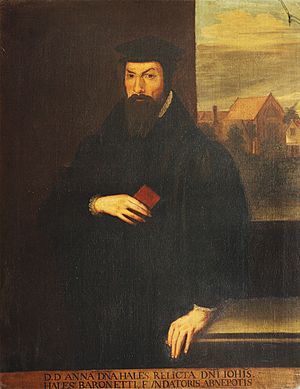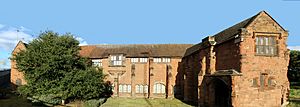John Hales (died 1572) facts for kids
Quick facts for kids
John Hales
|
|
|---|---|

late 16th C–early 17th C
|
|
| Born | c.1516 |
| Died | 26 or 28 December 1572 |
| Parent(s) | Thomas Hales |
John Hales (born around 1516 – died in 1572) was an important person during the Tudor period in England. He was a writer, a government worker, and a member of Parliament.
Contents
John Hales's Family Life
John Hales was the son of Thomas Hales. His family lived in Kent, England. John had four brothers and one sister. His brothers included Christopher, Bartholomew, and Stephen. His sister was Mildred. Some of his siblings became important people through their marriages.
Working for King Henry VIII
John Hales was a very smart person. He taught himself many languages, like Greek, Latin, and Hebrew. He also studied law.
He started his career working for important government officials. By 1535, he was working for Thomas Cromwell, a powerful advisor to King Henry VIII. Later, he became a clerk in a government office that handled taxes. He also helped Sir Ralph Sadler with his duties.
During this time, King Henry VIII was closing down monasteries. This was called the Dissolution of the Monasteries. John Hales bought some of these former church buildings. In 1540, he bought a priory in London. In 1544, he bought the Whitefriars monastery in Coventry.

Hales turned part of the Whitefriars into his home. He also used another part to start a free grammar school. In 1545, he officially opened this school as the King Henry VIII School. He gave land to help pay for the school's running costs.
Serving King Edward VI
When King Edward VI became king in 1547, John Hales continued to be important. He became a Justice of the Peace in two areas. He also became a member of Parliament for Preston.
Hales strongly supported the economic ideas of Protector Somerset, who was King Edward's uncle and a powerful leader. Hales was against the practice of enclosing land. This meant fencing off common land, which often hurt poor farmers. He worked hard to fix this problem.
However, when Protector Somerset lost his power in 1549, Hales was put in the Tower of London. This was probably because he supported Somerset's policies. He was released in 1550. After this, he left England for a while.
Living in Germany
John Hales lived in Germany with his brother Christopher. They stayed mainly in a city called Frankfurt. While there, he became good friends with a famous scholar named Sturmius. He remained in Germany until Queen Elizabeth I became queen.
Working for Queen Elizabeth I
Hales returned to England by 1559. He got his old job back in the government. From 1563 to 1567, he was a Member of Parliament for Lancaster.
However, Hales soon lost the Queen's favor. He wrote a book about who should become queen after Elizabeth. This book was called A Declaration of the Succession of the Crowne Imperiall of Inglande. In it, he argued that the descendants of King Henry VIII's younger sister, Mary, should be next in line.
At the time, Queen Elizabeth had no children. Mary's granddaughter, Lady Catherine Grey, had secretly married Edward Seymour. The Queen had put both of them in prison. Hales believed that if Queen Elizabeth had no children, Lady Catherine should be the next queen.
Because of this, Hales was also put in prison. Sir William Cecil, an important advisor to the Queen, wrote about how upset the Queen was.
With Cecil's help, Hales was released from prison in 1566. But he remained under house arrest for the next four years.
John Hales's Death
John Hales died in December 1572. Some records say he died on the 26th, others on the 28th. He was buried in a church in London. He was sometimes called "Club-foot" Hales. This nickname came from a story that he accidentally hurt his foot with a dagger.
John Hales's Writings
John Hales was a writer. Around 1543, he wrote a book called Highway to Nobility. He also wrote a grammar book, Introductiones ad grammaticum, for the free school he founded. In 1543, he published a translation of a book by Plutarch called Precepts for the Preservation of Health.
Many people believe Hales also wrote an important book about economics. It was called The Discourse of the Common Weal of this Realm of England (1581). Some experts think this might be the very first economics book written in English.
Who Inherited John Hales's Property?
John Hales never married. He left most of his property to his nephew, John Hales. This nephew was the son of his brother Christopher.

